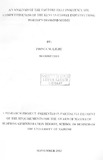| dc.description.abstract | Porter’s Diamond Model explains the reasons behind the competitiveness of nations in particular industry, that is, why nations are renowned for excelling in particular industries and not others. This study objective was to determine the factors that influence the competitiveness of the Kenyan coffee sector in the global markets using Porter’s Diamond Model. This survey study finds the Kenyan coffee industry not competitive in the sense of Porter’s Diamond Model. High initial costs are keeping new entrants from the industry possibly killing innovation. The technology used is old, the channels of distribution are not efficient, there is strong control from the government through the Coffee Board and there are no strong support industries. There are other factors that are limiting the competitiveness of the coffee industry and these include: the high cost of capital; the delays caused by government bureaucracy in issuance of licenses; the rigid government rules and regulations on how to operate within the industry; poor road and other infrastructure. Further, the high cost of coffee, low demand for coffee and coffee products locally, the high capital requirement for operating in the industry affects the competition from local rivals, and does not stimulate innovation.
However, the coffee industry in Kenya has factors that can make it more competitive in the global market. The lack of raw material is not a problem in the industry, companies in the industry do not exert influence on who can join the industry, thereby making the market open for any new entrant, and there is no competition from cheaper coffee imports. Further, high taxes is not a problem in the coffee industry, the atmospheric condition are favourable for coffee production, there is high potential of creating a strong local demand, the country’s business climate is ideal for investment in coffee and the ties with research institutions have
contributed to success in the coffee industry. | en_US |



